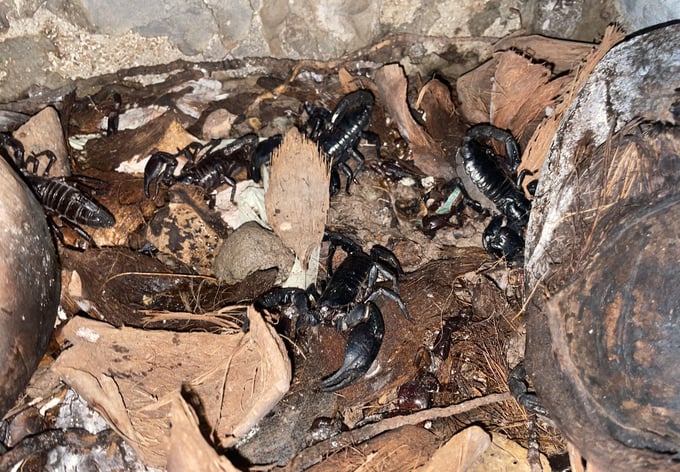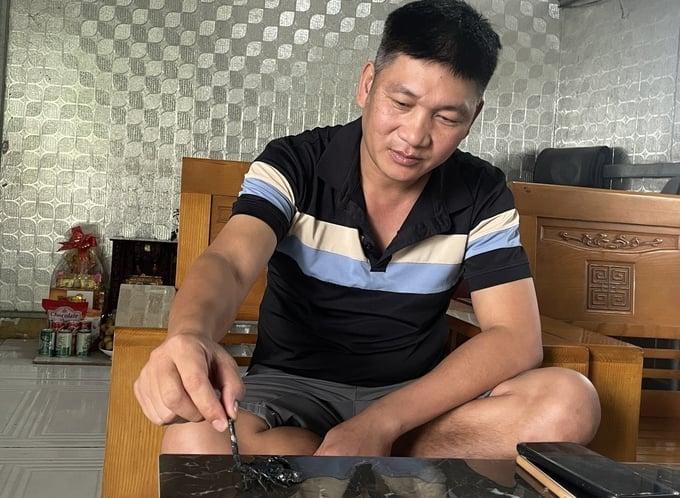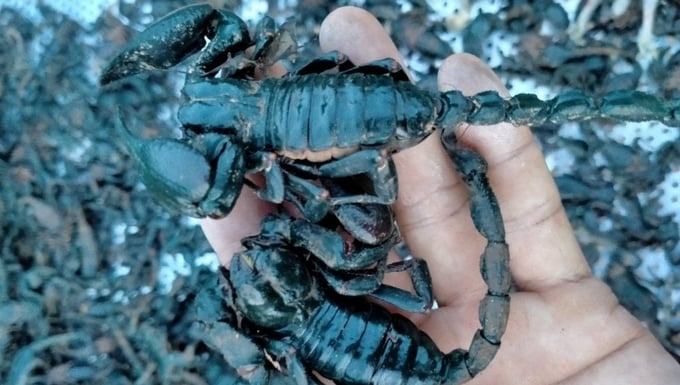May 31, 2025 | 12:34 GMT +7
May 31, 2025 | 12:34 GMT +7
Hotline: 0913.378.918
May 31, 2025 | 12:34 GMT +7
Hotline: 0913.378.918
At the beginning of 2012, Mr Lam Ngoc Tam (40 years old, from Thuong Tin, Hanoi) left his IT job to travel to Thailand and learn scorpion farming techniques.
Mr Tam explained, "The scorpions raised for commercial purposes are black scorpions, which are not venomous. Their sting is only as painful as an ant bite."
Starting with over 30 square meters of scorpion farming area, with a loss rate of over 50% due to insufficient technical knowledge, Mr Tam now has more than 600 square meters of scorpion farming area across two facilities.
The scorpion farming area is divided into compartments with an area ranging from 15 to 20 square meters. Each compartment can house about 1,000 to 1,500 scorpions.
As scorpions are hard-skinned animals that prefer hot and humid environments, the farming area has been arranged and modified to ensure the appropriate temperature and humidity for the scorpions' growth.
According to Mr Tam, the ideal temperature range for scorpions to thrive is between 20 and 25 degrees Celsius.

The living environment for scorpions must be kept sufficiently humid to ensure they develop optimally. Photo: Minh Toan.
On extremely hot days, scorpions need to be sprayed with water to maintain humidity and lower their temperature. Scorpions are relatively easy to raise as they are almost disease-free; however, there is still a loss rate.
Each breeding cycle at Thanh Tam Farm experiences a loss rate of about 2-3% of the total scorpion population. This is because if the temperature gets too high, the scorpions will fight. Additionally, if they are hungry, they can cannibalize each other.
Scorpions are fed crickets, earthworms, and groundfish. They usually eat at night and require feeding only three times a week. An adult scorpion eats just one cricket per feeding. For smaller scorpions, it might take two to finish one cricket.

Mr Tam shared: "These scorpions are not poisonous, but handling them still requires technique to avoid being stung". Photo: Minh Toan.
Tam's farm utilizes all available resources to support this breeding model. In addition to scorpions, Thanh Tam Farm also raises crickets and belostomatids.
Commercial crickets are sold, while waste crickets become food for the scorpions. Similarly, surplus fish from the belostomatid's diet is ground up to feed the scorpions.
Tam also breeds his own scorpions. Each square meter can house up to 60 breeding scorpions. Each pair produces 12 to 15 young scorpions. The breeding cycles overlap, so Tam's farm always has stock. It takes about 90 days from birth for scorpions to reach marketable quality.
Tam mentioned that scorpions are easy to raise: "Scorpions can be raised anywhere, utilizing old pig or cow pens, or even outdoors. They eat little, have few diseases, and the loss rate is low, with harvesting possible in just 90 days".
The profitability of scorpion farming is significant. Farmers can optimize costs for enclosures and feed. With low investment costs and high product prices, Tam has transformed his life with this breeding model.
The largest expense in constructing each pen is the metal sheeting used to enclose the area, preventing the scorpions from escaping. With VND 500,000 worth of metal sheeting, one can enclose an area of about 20 square meters, housing between 1,000 to 1,500 scorpions.
While the metal sheeting is the most expensive component, creating a warm, humid environment for the scorpions is inexpensive, as it is done using coconut husks. Tam explained, "You can get coconut husks for free from local vendors."
Additionally, there is no need to clean the scorpion pens frequently. Tam noted, "We only clean the pens between batches to prepare for the new ones, so frequent cleaning is not necessary".

Scorpions are dried to extend their shelf life and serve various purposes. Photo: NVCC.
Additionally, the cost of feeding scorpions is relatively low. One thousand scorpions consume only about 3-5 taels of food per feeding. Groundfish is the cheapest food option, costing about VND 7,000/taels. Crickets, which are more expensive, cost about VND 10,000/taels. From the start of their development until maturity, 1,000 scorpions only consume about VND 100,000 worth of food.
Scorpions are not particularly picky eaters. Both crickets and fish used as food for scorpions can be frozen. Crickets need to be blanched in boiling water to prevent spoilage during freezing. When feeding scorpions, the food must be thoroughly thawed, as otherwise it can negatively impact their development.
Each kilogram of commercial scorpions sells for VND 300,000-350,000. About 60-70 mature scorpions make up 1 kilogram of commercial product. According to Mr Tam, for each kilogram of scorpions, after deducting all costs, the profit is VND 200,000-250,000 per kilogram.
Currently, Thanh Tam Farm also sells scorpion breeds for VND 15,000 each. According to Mr Tam, this is "the cheapest on the market" because, besides selling the breeds, he also provides breeding techniques and buys back the products from households that purchase breeds from Thanh Tam Farm.
In addition to being considered valuable medicinal ingredients, scorpions are also a relatively nutritious food source. Therefore, besides being sold fresh, scorpions are also dried to serve various purposes and ensure longer storage times.
Not only does the domestic market play a significant role, but the foreign market also accounts for a substantial share of Mr. Tam’s output.
Translated by Hoang Duy

(VAN) Seafood by-products are opening a new path, combining green growth and technological innovation to enhance the industry's value.

(VAN) Mr. Nguyen Thanh Cong, Vice Chairman of the Son La Provincial People's Committee, reflects on Son La’s journey from barren hills to fruitful orchards after a decade of hard work.

(VAN) FAO’s Director-General addresses the 5th Baghdad International Water Conference.
/2025/05/26/1716-4-nongnghiep-191706.jpg)
(VAN) Chain linkages, technological innovation, and raw material zoning are three strategic pillars for the coconut industry to strongly develop and elevate its position on the global agricultural map.
![Advanced mariculture – an inevitable trend: [4] Accompanied by scientists](https://t.ex-cdn.com/nongnghiepmoitruong.vn/608w/files/sohk/2025/05/13/1941-pgsts-vo-van-nha-140958_717.jpg)
(VAN) According to Assoc. Prof. Dr. Vo Van Nha, Director of the RIA III, the development of advanced offshore mariculture is no longer an option but an essential path for Vietnam’s fisheries sector.

(VAN) Vietnam is intensifying the development of mollusk farming areas that meet international standards, aiming for sustainable growth and enhancing its export position in the global seafood market.
![Advanced mariculture – an inevitable trend: [3] Policy-driven momentum](https://t.ex-cdn.com/nongnghiepmoitruong.vn/608w/files/doanhtq/2025/05/21/0104-0616-0348-nuoi-bien-170339_789.jpg)
(VAN) To ensure the success of offshore mariculture that uses advanced technologies, it is essential to establish supportive policies that inspire both individuals and enterprises to invest with confidence.